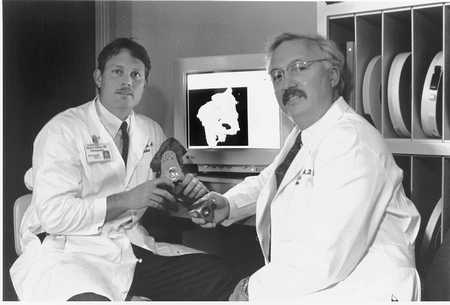
Drs. David DeBoer (left) and Michael Christie are working to develop new hip replacement technology.
New implant may eliminate repeat hip replacements
A new hip replacement technique pioneered at Vanderbilt University Medical Center may soon eliminate the need for subsequent replacement procedures by holding better and lasting longer than current methods.
Dr. Michael J. Christie and Dr. David K. DeBoer, both assistant professors of Orthopaedics and Rehabilitation, are working on perfecting a new type of acetabular implant used in second, or revision, hip replacements. Dr. Christie is one of the first surgeons in the nation to use such an implant.
"Patients often need revision surgery when their original prosthesis becomes loose. The problem is that there is usually less bone available to reconstruct the hip joint in the revision setting," DeBoer said.
In hip replacement surgery, there are two components used to form a ball and socket hip joint. The femoral component is implanted into the upper part of the femur or thigh bone. The acetabular component is actually a round hemispherical cup that is attached to the pelvis.
The new cup being developed by Christie and DeBoer is called the Triflange cup. It is a standard round cup with three extensions or flanges on it. Because there is significant pelvic bone loss, the flanges bypass the bony defects and extend onto the three major bones that form the pelvis. The cup is bolted in place onto the patient's remaining good bone to provide a more stable support for the prosthesis, Christie says.
The impetus, Christie says, for developing the Triflange cup was the poor short and mid-term results when using other methods of reconstructing the acetabulum. Christie believes the Triflange cup will hold better and last longer than the other methods.
DeBoer says they have seen very good early results. While they are still in the short-term stage of the Triflange implant research, none of the 50 or so implanted over the past four years has failed, he says.
"We are excited about the results. Being a tertiary care hospital, we see a lot of patients who get referred to Vanderbilt because they have very difficult reconstructions," DeBoer said. "The first few patients that Dr. Christie operated on averaged between three and four previous hip revisions prior to coming to Vanderbilt. Most of the patients were wheelchair-bound and had given up on ever walking again.
"One lady I remember had nine previous hip surgeries and was in so much pain that she stayed in bed all day. When we saw her recently for a check-up, I couldn't believe it was the same woman. She was walking again, using a walker, and was able to attend social functions at her church. It's made a tremendous difference for her whole family," DeBoer said.
Christie has helped develop prostheses for hip replacement patients prior to the Triflange model.
In 1986, he began developing an elliptical-shaped or oblong acetabular cup.
"One thing that we were noticing was the presence of an elliptically-shaped bone defect in the pelvis of some of the early revisions," Christie said. "Up to that point, standard round hemispherical implants were all that were available and they required the addition of a structural bone graft for support."
The process started by taking a CAT (computerized axial tomography) scan of the patient's pelvis.
"A three-dimensional model of the pelvis was made which helped define what the bone defect looked like and then a custom oblong prosthesis was made to fit into the pelvis of the patient. The key is to properly fill the bony defect with the prosthesis for intimate contact between the patient's bone and the prosthesis while placing the cup in the correct position," Christie said.
The oblong cup proved to be so successful that they were standardized and developed into a mass-produced off-the-shelf prosthesis and are now in use all across the country.
"Patients who have received the oblong cup implant are doing very well," Christie said. "We have followed about 20 patients for seven years now and we haven't had any failures, yet."
An incentive to perform a proper hip replacement is that most of the patients are elderly, Christie says.
"That is why you want to do an operation that is not going to fail in 5 to 10 years. It is so critical that we find a method that we can use that is going to last long enough so no additional surgery is needed," Christie said.
The Triflange cup is still in the custom manufacturing stage. DeBoer is using computer technology to try to better understand the bony defects in the pelvis.
"We have been examining the shape and location of the defects and are trying to figure out a way to standardize the Triflange cup.
"We are having to do more and more revisions because more and more primary hip replacements are being performed in younger patients. We need to find some implant that will work at correcting the defects in the hip and provide a good hip replacement. We think Triflange cups are the best option," DeBoer said.
The doctors have already presented their findings to an international meeting on custom prostheses.
They believe the Triflange cup will become the standard for many revision hip replacements and could ultimately be used in initial hip replacement surgeries.
"I think there are some pretty neat things that are on the horizon here. We need to continue our clinical research, checking on how our patients are doing while at the same time doing our basic science research to see if we can make the implant better," DeBoer said.
"The goal is to get an implant that we can put in which will last the patient for life."













